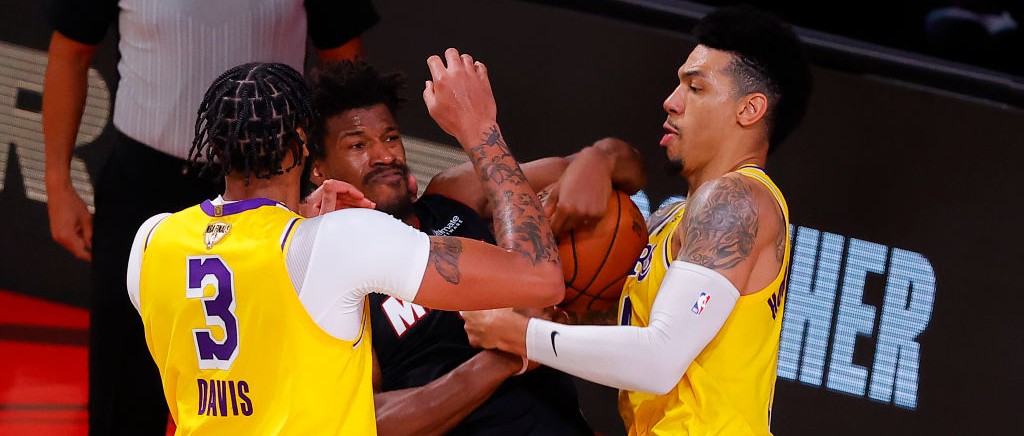The Lakers have faced four very different opponents thus far this postseason, but have remained defensively stout against them all, utilizing different lineups and adapting their approach by tailoring a scheme specific to the opponent.
Against the Blazers, Rockets, and Nuggets they saw just about every kind of attack you can think of in the modern NBA, and while they haven’t always been perfect, they’ve been willing to adjust in a way some great defenses aren’t. The Lakers have strong defensive principles, but they aren’t wholly set in their ways in how they do things like pick-and-roll coverages to the point that they become predictable and easily exploited. A big part of this comes from the versatility of their defenders, starting with Anthony Davis and LeBron James, but extending to quality perimeter defenders in Alex Caruso, Kentavious Caldwell-Pope, and a rejuvenated Rajon Rondo.
In Game 3, Jimmy Butler attacked a weakness in the Lakers gameplan, as they willingly switched every screen and allowed him to hunt favorable matchups. In Game 4, they switched Davis onto Butler at the request of Davis, and early on, Butler went back into matchup hunting mode, as the Lakers would switch every time Bam Adebayo came to set a screen, allowing Butler to pull Dwight Howard to the perimeter and attack him off the dribble.
Lakers put AD on Jimmy Butler. Miami responds by having Bam screen for Jimmy. Lakers switch that. Butler has to be able to attack Dwight to make this work for Miami. Get him in foul trouble, make plays, force help, beat him off the bounce. pic.twitter.com/rLFMU3JY8w
— Steve Jones Jr. (@stevejones20) October 7, 2020
As the game went on, the Lakers made another adjustment, as they had Davis and anyone else who was tasked with being Butler’s primary defender, to go under screens and not switch them. The result was an 8-for-17 night for Butler, and maybe more importantly, just seven trips to the free throw line after 14 such visits in Game 3, many of which came by attacking lesser defenders. By keeping primary defenders sunken back on Butler, daring him to shoot jump shots, they cut off his driving lanes and didn’t allow him to create the same looks for himself and for others as Game 3. This possession in the early fourth quarter is a great example of Butler trying to get a switch onto Kyle Kuzma. Unlike in Game 3, when LeBron willingly gave him that switch, the Lakers had him go under twice, holding up Jae Crowder before staying with Butler each time to keep that same matchup.
Lakers going under vs. Jimmy Butler takes away the mismatch hunting. Iguodala has Kuzma guarding him and screen for Jimmy. LeBron is back and goes under. Iggy tries to screen his own man but the switch is not happening. Ends up with a pop/contested 3. pic.twitter.com/aQ7dTPsGio
— Steve Jones Jr. (@stevejones20) October 7, 2020
Davis’ impact on Butler was noticeable, as he employed many of the same tactics he did against Russell Westbrook in the Houston series. By sagging back, knowing Butler didn’t want to settle for long jumpers, he made it impossible to get to the rim. His length and quickness allows him to contest Butler when he pulls up from the short mid-range, where he’s very good against smaller defenders.
— Steve Jones Jr. (@stevejones20) October 7, 2020
On top of taking the rim away from Butler, sinking under screens took away passes to Adebayo on the roll. When they force the ball to Tyler Herro, who isn’t nearly the facilitator Butler is on the ball, they also limited Adebayo’s impact while asking the volume-shooting rookie to carry an immense load.
Frank Vogel and the Lakers staff deserve a ton of credit for their willingness to continue adapting their gameplan to counter every punch thrown by their opponent throughout this postseason. Favorites so often have a hubris about them that doesn’t let them make adjustments until it’s too late, but for the Lakers, there isn’t some devotion to a system as much as there is a commitment to the effort and principles they call for. The buy-in on that end, particularly from even their lesser defenders — Kyle Kuzma’s effort on defense this postseason in particular has been notable — is a credit to the staff and to their two stars for leading by example in that area.
Vogel isn’t often discussed among the league’s best coaches, in part because any time you have two elite superstars, there’s an expectation that the coaching job is easier or has a lesser impact. While he’s perfectly happy to let James and Davis get the rightful praise they do, what he’s done this season and especially this postseason with the L.A. defense is nothing short of remarkable. This is a Heat team that dismantled the Bucks defense — admittedly with Goran Dragic exerting immense pressure the Lakers haven’t had to deal with — but like every previous Laker opponent this playoffs, they are finding it tough sledding, particularly in key moments thanks to the Lakers willingness to adapt.







